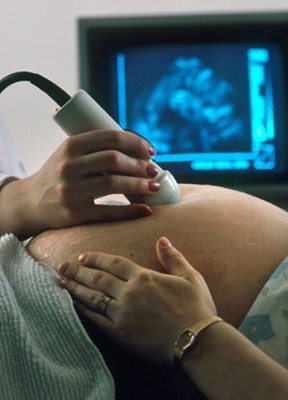科學技術
Three-dimensional printing
3D印刷
An image of the future
印刷未來
One of the biggest manufacturers in the world gives 3D printing a go
世界龍頭機器制造商用3D印刷術進行了一次格外成功的應用
ULTRASOUND scanners are used for tasks as diverse as examining unborn babies and searching for cracks in the fabric of aircraft.
超聲波掃描器的應用領域很廣,小到用于檢查胎兒,大到飛行器機體瑕疵檢測等。
They work by sending out pulses of high-frequency sound and then interpreting the reflections as images.
機理過程是,通過發射高頻聲波脈沖信號對反射信號進行成像解讀。
To do all this, though, you need a device called a transducer.
但完成該過程,你不能缺少一臺叫做壓電式換能器的設備。
 Transducers are made from arrays of tiny piezoelectric structures that convert electrical signals into ultrasound waves by vibrating at an appropriate frequency.
Transducers are made from arrays of tiny piezoelectric structures that convert electrical signals into ultrasound waves by vibrating at an appropriate frequency.
壓電式換能器是由具有壓電效應的一系列敏感元件機構組成。敏感元件機構通過定頻震蕩將電信號轉換成超聲波。
Their shape focuses the waves so that they penetrate the object being scanned.
機構的特定外形可聚焦超聲波,對被掃描的物體產生穿透作用。
The waves are then reflected back from areas where there is a change in density and on their return the transducer works in reverse, producing a signal which the scanner can process into a digital image.
超聲波會從密度發生變化的介質反射回來,這時壓電式換能器會反向操作產生信號,再經過掃描器的處理,最后進行數字成像。
To make a transducer by painstakingly micro-machining a brittle block of ceramic material can take many hours of work, though.
壓電式換能器需要用到陶瓷材料,而精密地加工一塊精細的陶瓷材料就要耗費幾個小時的工作時間。
As a result, even as the size and cost of the console that controls the scanner has fallen with advances in microelectronics,the cost of making the probe itself remains stubbornly high—as much as ten times that of the console.
隨著微電子領域中,技術的突飛猛進,控制掃描儀的電路板無論從體積還有成本都有很大程度的優化變小和降低。有些電路板小到可以裝進醫生口袋里面,成本也不過幾百美元的價格。而制作換能器探頭的成本卻一直居高不下,跟電路板相比,探頭的制作成本大概是一塊電路板的10倍左右。
At least, it does if you use traditional subtractive manufacturing techniques like cutting and drilling.
即使不考慮體積及成本的情況下,傳統的對比相減式加工流程技術也能完成這些工作,比如切割,機鉆等。
However GE, a large American conglomerate, is now proposing to make ultrasound transducers by additive manufacturing—or three-dimensional printing, as it is also known.
而GE作為美國的一個龐大的企業集團正考慮采用對比添加式的加工流程來加工超聲波壓電式換能器。
A new laboratory at the firms research centre in Niskayuna, New York, is taking a hard-headed look at the technique, which some see as a fad and others as the future, and working out which products might be made more efficiently by addition rather than subtraction.
GE在紐約Niskayuna地區的研發中心新成立了一個實驗室,目前該實驗室正本著理性實際的態度對該項技術進行研發,力圖找到哪些產品用對比添加式而非對比相減式的技術流程加工生產更加適合。一些人認為,對該項技術的研發只不過是一時狂熱。還有一些人聲稱,目前的時機并不成熟,對該項技術的研發僅僅具有將來時的意義罷了。
Ultrasound transducers were an early pick both because of the complicated geometry needed to focus the sound waves and because ceramics are harder than metals to cut and drill accurately.
最初選擇超聲波壓電式換能器來作為3D印刷術的對象原因有兩點。一是該換能器用來聚焦聲波的機體外形非常復雜,二是它用到的陶瓷材料比金屬的硬度要高很多,很難進行精準地切割和機鉆。
But they are easy to print.
而用3D印刷術卻很容易解決這兩個難題。
The GE process for making a transducer begins by spreading onto the print table a thin layer of ceramic slurry containing a light-sensitive polymer.
GE對加工換能器的方法是首先在印刷臺上撒上薄薄的一層陶瓷粘土,其中混入一種光敏聚合體。
This layer is exposed to ultraviolet light through a mask that represents the required pattern.
然后用紫外線通過露光模板的光孔照射到印刷臺的粘土層,以此塑造出需要的模型圖案。
Wherever the light falls on the polymer it causes it to solidify, binding the particles in the slurry together.
光敏聚合體一經被紫外線照射就會立即變得堅硬,粘土中的粒子隨即凝結固化。
The print table is then lowered by a fraction of a millimetre and the process repeated, with a different mask if required.
接下來,印刷臺會以不超過一毫米的距離向下位移,然后重復整個上面這一過程,如果有必要,需要重新更換一個新的露光模板。
And so on. Once finished, the solidified shape is cleaned of residual slurry and heated in a furnace to sinter the ceramic particles together.
以此反復處理直到整個過程結束,再進行清理成模上的殘余粘土,最后把成模放入熔爐,以低于熔點的溫度進行焙燒,最終完成陶瓷粒子的凝固收縮聚合。
More work will be needed to turn the process into a production-ready system.
該處理流程在具有批量生產體系能力之前,還需要做很多的工作。
But Prabhjot Singh, who leads the project, hopes that it will be possible to use it to make not just cheaper ultrasound probes, but also more sensitive ones that can show greater detail.
但項目負責人Prabhjot Singh表示,希望不僅僅制造出成本相對低廉的超聲波探頭,最好探頭的靈敏性也會更高,這樣可以讓我們通過成像看到更加細節化的信息。
Although researchers have had new transducer designs in mind for years, it has been impractical to construct them subtractively.
多年以來,壓電式換能器的研究者們一直都有新型設計的想法,但應用對比相減式的加工流程實際上很難能把這樣的構想變為現實,
Additive manufacturing could change that.
而對比添加式很可能會使這種困頓得到改善。
The new laboratory will look at other forms of additive manufacturing, too.
GE的新實驗室還將研究其它對比添加式的加工流程。
Some 3D printers spread metal powders on the print table and sinter the pattern with lasers or electron beams, rather than using masks.
比如一些3D印刷機在印刷臺鋪撒金屬粉末之后,采用露光模板以外的激光或電子束方式進行熱凝處理來產生樣模。
Others deposit thin filaments of polymer in order to build structures up.
其它流程,如混入聚合體熱敏細絲通過自加固原理進行聚合以產生成模。
GE is interested in how the technology could be used right across the firms businesses, from aerospace to power generation and consumer products, according to Luana Iorio, head of manufacturing technologies at GE Global Research.
GE全球研發中心制造技術中心主任Luana Iorio指出,GE旨在為各種商業形式,包括象航空航天、能源及消費產品等領域提供令人滿意的3D印刷技術。
The gains include less waste and the ability to make bespoke parts more easily.
這種技術的獲益在于節約耗材和使第三方定制個性化零部件變得更加容易。
But one of the most compelling advantages is freeing designers from the constraints of traditional production.
但最無可爭辯的優勢之一是讓設計者從傳統工藝的桎梏中解脫出來。
Those constraints include having to design things not in their optimal shape but to be machined, often as a series of pieces.
這些限制包括,設計者不得不用多個零部件去實現一個功能,不能從最優化的外形尺寸來設計產品。
Additive manufacturing can combine parts into a single item, so less assembly is needed. That can also save weight—a particular advantage in aerospace.
對比添加式可以整合零部件,避免了一些繁瑣的機械組裝過程,同時減輕了重量,這點對航空航天領域尤為有利。
These new production opportunities mean manufacturers, big and small, are about to become a lot more inventive.
在這種新的生產有利背景下,意味著制造商們,無論規模大小,都將變得更加具有創造性。
 Transducers are made from arrays of tiny piezoelectric structures that convert electrical signals into ultrasound waves by vibrating at an appropriate frequency.
Transducers are made from arrays of tiny piezoelectric structures that convert electrical signals into ultrasound waves by vibrating at an appropriate frequency.
 Transducers are made from arrays of tiny piezoelectric structures that convert electrical signals into ultrasound waves by vibrating at an appropriate frequency.
Transducers are made from arrays of tiny piezoelectric structures that convert electrical signals into ultrasound waves by vibrating at an appropriate frequency.